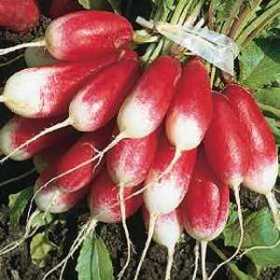
Thanks to John Harrison of Allotment & Gardens
Summer radishes can be ready to harvest in as little as 18 days from sowing (20-30 days is more usual). They are easy to grow, making them ideal for children to sow and see very fast results. Once they can see the magic of gardening they will be hooked for life.
Summer or Salad Radishes
There are many varieties of salad radish available ranging in colours from red through purple and yellow to white.
Japanese or Asian (Mooli) Radishes
Japanese or mooli radishes are slower growing larger roots which can grow up to 12 inches (30cm) long. Because they are in the ground for longer than the summer varieties the soil will require preparation as for root crops. Proper crop rotation is advisable to help reduce the risk of club root .
These radishes are sown directly, usually about 1-2cm deep about 4-5 inches (10-13cm) apart with 10 inches (25cm) between rows. Most Asian radishes are sown during May-July as earlier sowings may bolt. They are ready about 8 weeks after sowing and will often stand for a few weeks in the ground before harvesting.
Winter Radishes
Large winter radishes are usually sown in late summer and should be grown in the same way as parsnips. Leave them in the ground until required. Protecting with straw or fleece in frosty weather to prevent the ground from freezing so that you can harvest them .
Varieties of Radish
Summer Radishes
- French Breakfast 3 is probably the most popular of all radishes. Its cylindrical roots are crisp and mild with a white tip and red crown.Awarded the RHS Award Of Garden Merit (AGM).
- Scarlet Globe is another popular variety. Its deep red globes are quick maturing and good for early spring sowing.
- Amethyst isa very striking new variety. Its deep purple skin has a slight metallic sheen, which contrasts very well with the crisp , crunchy white flesh. It is slow to go woody. Making successional sowings ensures a constant harvest .
- Zlata is an unusual yellow skinned radish with a moist, juicy texture , strong but not too peppery flavour. It produces superb roots throughout the spring and summers that are slow to go woody so will stand in the ground for longer .
- Rudi is a variety thatshould be considered for forcing under glass. It is a dark red globe shaped radish. Awarded the RHS Award Of Garden Merit (AGM).
Asian and Winter Radish
- Mantanghong whichwas actually bred in Britain its outer skin is greenish and white but the flesh is a bright magenta. It’s crisp and mild flesh has a sweet and slightly nutty taste. Sow in July-early August to harvest September onwards. They will survive all but the hardest frosts and can be left in the ground until needed. Good for salads, the large roots can also be served as a winter vegetable.
- April Cross has white cylindrical roots which are often up to 12in (30cm) long. They are exceptionally crisp, crunchy and mild and are excellent in salads and stir fries.
- Tsukushi Spring Cross F1 is a hHybrid which is fully winter hardy, its roots will remain in perfect condition in the ground over a long period, or they can be lifted and stored the same as other root crops. Tsukushi produces shorter 25cm (10in) long roots, 6cm (2½in) in diameter making it easier to lift . It is best grown for autumn and winter production.
- Black Spanish This has probably been grown since the 16th Century or even before. It is a good round-rooted variety with a deep, near-black skin and snowy-white flesh with a fine, fairly hot flavour, good raw or cooked. Will keep all winter in good conditions.
Radish Pests and Problems
Although radishes are from the brassica family and theoretically susceptible to clubroot, the summer varieties develop too quickly to be affected. Two pests that do bother them , though , are slugs and flea beetles. Both of which eat the root at best making them look unappealing on the table. The Asian and winter varieties which are in the ground longer will need to be grown more carefully.
Cultivating Radish
Summer radishes grow so fast they are often thought of as a catch crop and can be excluded from your rotation plan. They are a very easy to grow crop but they do like a light soil with plenty of humus.
Wherever there is a small space you can thinly sow some seeds. Sow them about an inch (3cm) apart and cover with about a half inch (1cm) of soil. Water well and harvest as needed but before they begin to go woody , so harvest young and compost when they start to show signs of age. Sow a few seeds every week or so from Mid-March until Mid-July and under glass in January and February for an early crop. Harvest from May until August.
If the weather is hot they like a little shade and can even be grown in the shadow of other crops. Summer radishes are also often used as a marker crop when sowing such things as parsnips. Sow radish in the same row as the parsnips and they will be ready to harvest by the time the parsnips have germinated.
Winter Radishes are sown directly, usually about 1-2cm deep about 4-5 inches (10-13cm) apart with 10 inches (25cm) between rows. Most Asian radishes are sown during May-July as earlier sowings may bolt. They are ready about 8 weeks after sowing and will often stand for a few weeks in the ground before harvesting.
